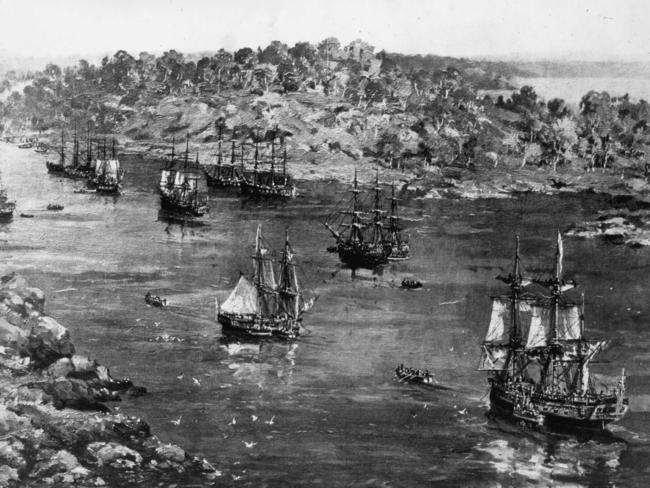Convicts’ first Christmas in Australia marred by crime
Eleven months after the First Fleet landed, Christmas was “observed with proper ceremony” according to a report from the time. But not all the convicts were prepared to make do with their extra ration of rum.
Today most Australians will sit down to Christmas lunch or perhaps dinner, eating everything from traditional roasts and hot pudding to seafood feasts with fresh fruit. But whatever they tuck into, and wherever they eat, it will probably bear little resemblance to the first Christmas held in this country.

When the British officers and their convict charges arrived aboard the First Fleet in January 1788 to begin their colonisation of NSW, they brought many British festive traditions. In 18th-century Britain most people feasted on roast beef, goose, rabbit or (if they could afford it) turkey for Christmas.
Preserved meats were also popular as farmers ate the first of the smoked, salt-cured or sugar-cured meats they were preparing for the coming coldest months of the year. There would also be a selection of the last fresh fruits and vegetables of the harvest, along with the first pickled ones.
For dessert there was something resembling a plum pudding, which had actually evolved from a way of preserving meat to a dessert made with suet, flour and dried fruit. But at the time it had not taken on its familiar semi-spherical shape.
The availability of produce in Australia would determine what form the feasts would take here. In the first year, colonists had discovered some of the bounty of fish and other creatures from the local waters and sampled some of the birds and native marsupials. But the Europeans were not as skilled as the Aborigines at recognising the abundance of what we now call “bush tucker” and had failed to make the thin Sydney soils yield much with their European crops. This had meant a greater reliance on stores brought from England.

Lieutenant David Collins said: “Christmas day was observed with proper ceremony. Mr Johnson [Reverend Richard Johnson] preached a sermon adapted to the occasion, and the major part of the officers of the settlement were afterward entertained at dinner by the Governor.’’
Our Criminal History: Story behind Australia’s only pirate
Early outlaw: Baby-faced bushranger our most wanted
The officers endured the heat in full dress uniforms as they dined in the governor’s house. The menu is not known but since there was only one surviving sheep in the colony, it is a safe bet that lamb was not on it. Goose, rabbit, salt beef or fresh beef may have been consumed, followed by a pudding and a toast to George III and his family with port wine and brandy.
While the convicts had to be satisfied with only the usual rations of salt beef or pork, bread and biscuits, they were given an extra ration of rum.
Johnson also officiated at the marriage of convicts Susan Gibbs and John Forrester and baptised Sarah, the daughter of convicts William and Mary Eggleton.
Other convicts were also busy that day but they wouldn’t have made Santa’s good list. Amelia Levy and Elizabeth Fowles both prostituted themselves to two drunken corporals, in exchange for a shirt each, while convict Michael Dennison broke into the home of Edward and Mary Pugh to steal a pound of flour. With food so scarce, thefts were treated seriously.
He was later sentenced to 200 lashes but, perhaps out of a spirit of seasonal goodwill, he was only given 150.

Meanwhile, Norfolk Island was a little more festive for the convicts. The commandant, Lieutenant Governor Philip Gidley King, wrote: “The 25th, being Christmas-day, it was observed as a holyday. The colours were hoisted at sun-rise: I performed divine service; the officers dined with me, and I gave each of the convicts half a pint of rum, and double allowance of beef, to celebrate the festival: the evening concluded with bonfires, which consisted of large piles of wood, that had been previously collected for the occasion.’’
A year later the Sydney colonists would have reason for feeling nostalgic about that first Christmas. Supplies were running low and farming efforts were still faltering. A supply ship was lost at sea and rations were down to half those of the year before. The governor and his officers feasted on turtle from Lord Howe Island and cabbage, while convicts starved on bread and rotten salt pork.
In 1790 colonists were still doing it tough. But at Parramatta in 1791, 30 convicts refused to let their condition dampen their festive cheer. They broke into the marine stores and stole 100 litres of rum.
• This is an edited version of a story first published in December 2009.
MORE FROM TRUE CRIME AUSTRALIA
Picture specials: Policing in the ’50s | ’60s | ’70s
Book extracts: Bigwig | Eugenia | Stalked: The Human Target
Real-life farce: The utterly bizarre royal show prison break
Convictions quashed: Six times Australian justice got it wrong



